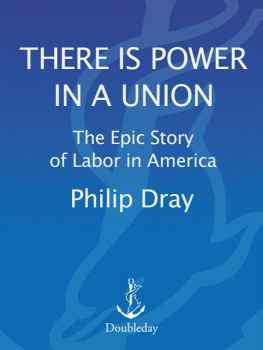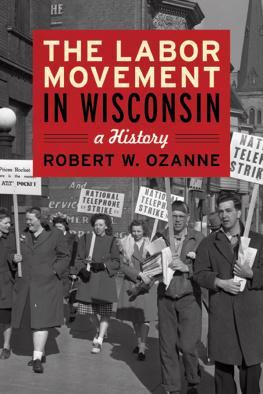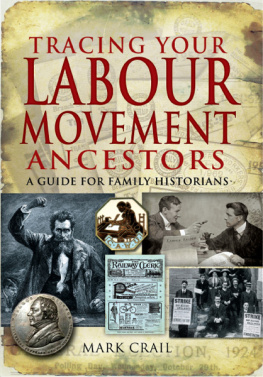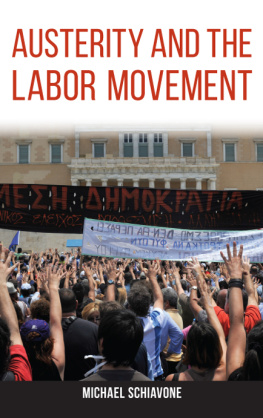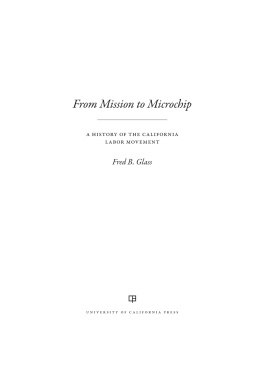LABOR RISING
LABOR RISING
The Past and Future of
Working People in America
Edited by
Daniel Katz and Richard A. Greenwald

Individual chapters 2012 by each author
All rights reserved.
No part of this book may be reproduced, in any form, without written permission from the publisher.
Requests for permission to reproduce selections from this book should be mailed to: Permissions Department, The New Press, 38 Greene Street, New York, NY 10013.
Published in the United States by The New Press, New York, 2012
Distributed by Perseus Distribution
LIBRARY OF CONGRESS CATALOGING-IN-PUBLICATION DATA
Labor rising : the past and future of working people in America / edited by Richard A. Greenwald, Daniel Katz.
p. cm.
ISBN 978-1-59558-798-5
1. Labor movementUnited StatesHistory. 2. Working classUnited StatesHistory. I. Greenwald, Richard A. II. Katz, Daniel, 1962
HD8066.L327 2012
331.880973dc23 2012001464
Now in its twentieth year, The New Press publishes books that promote and enrich public discussion and understanding of the issues vital to our democracy and to a more equitable world. These books are made possible by the enthusiasm of our readers; the support of a committed group of donors, large and small; the collaboration of our many partners in the independent media and the not-for-profit sector; booksellers, who often hand-sell New Press books; librarians; and above all by our authors.
www.thenewpress.com
Composition by dix!
This book was set in Scala
10 9 8 7 6 5 4 3 2 1
CONTENTS
The genesis of this volume occurred a few years ago in the boisterous environs of a hotel bar during the annual meeting of the Organization of American Historians. After a meeting of the Labor and Working-Class History Association, the conversation turned, as it often does for labor scholars, to the relevance of our work as historians to the wider labor and social justice movements. As we debated the relative merits of doing high theoretical analyses or sometimes engaging in the study of obscure historical moments, one thing became clear to us: every single one of our friends and colleagues entered into scholarly study because of a drive to contribute to movements that fight on behalf of ordinary peopleworkers, immigrants, women, and racial-ethnic minorities.
That evening, as the conversation turned to the state of labor today, what the movement needs, and how it needs to change or expand, our friends became even more animated. They argued, sometimes at high decibel levels, about how lessons from labors past struggles and victories could be applied today. It was during one particularly good-natured brawl that the co-editors turned to one another grinning and said almost at the same time, What a book this would make! Among those gleeful belligerents, many of whom ended up contributing to this book, and all of whom have supported us throughout the process, were Jennifer Klein, Nancy MacLean, Bethany Moreton, Kim Phillips, Jacob Remes, Jarod Roll, Shel Stromquist, and Heather Thompson.
Soon after that OAH meeting, we approached Alice Kessler-Harris about the idea. She responded immediately, helping us to think about how to develop a wish list of contributors balanced by themes, perspectives, and demographics. For that and the advice she gave us throughout the planning of this book project, we are very grateful to her. We then took the idea to Marc Favreau, who followed up his enthusiasm (fueled by the intoxicating ambience of a Brooklyn biergarten) with a contract, which we needed to pull the volume together. He championed this project unwaveringly and never failed to nip at our heels when we appeared to be dragging our feet. We are also grateful for those frequent Friday afternoons during which Lara Vapnek, Brendan OMalley, Jonathan Soffer, Daniel Levinson Wilk, and Ted Hamm offered us their encouragement and insights, along with their conviviality. And we would like to thank the many scholars who have helped shape our thinking on labor over the past few years, first and foremost the contributors to this volume.
In addition, Dan would like to thank Barry Eisenberg, Carolyn Helmke, Tara Maldonado, Laura McEnaney, Dave Staiger, Peggy Tally, Diane Ramdeholl, and Christopher Whann for their unflagging support. Jeffrey Trask and Jacob Remes offered valuable suggestions for improving my essay in this volume. As I write this, I am transitioning from Empire State College, where I spent the last seven years happily in the company of wonderful students and colleagues, to the National Labor College, where Id been appointed the dean of labor studies. Rich is to blame. He made joining the dark side seem like a really fun idea, not to mention important and fulfilling. That can be said about this volume as well. I have utterly enjoyed working with Rich and thank him for his friendship and mentorship. And, as always, I thank Patricia Jerido, Christina Jerido, and Amanda Jerido-Katz for their faith and pride in me.
Richard would like to thank the following for pushing him to become an engaged scholar: Liz Faue, George Sanchez, Robin D.G. Kelley, Bob Weisbuch, Eileen Boris, Ryan Harbage, Howard Stanger, Dewar MacLeod, Danny Walkowitz, Liz Cohen, Andrew Ross, and Jonathan Lethem. Drew University and St. Josephs College, my current academic home, encouraged my scholarly activity even with the demands of being a dean. It is rare that institutions provide this level of freedom for scholarship to administrators, so I am very thankful. I also need to thank Dan Katz, who is a first-rate scholar, an activist, and now a good friend. My wife, Debbie, and my two kids, Daniel and Annie, have provided the love and forgiveness an academic needs to write.
What is the future of working-class America? Does it lie within the labor movement or outside it? In an age of rapid and flexible global production and distribution, how can a working-class movement stretch beyond national borders to gather strength and power? When capital flows govern the world of human relations, how is working-class community to be imagined? And how to reach out beyond the present dismal outlook for workers all over the world, to imagine a world in which social justice prevails for poor people everywhere? The essays in this book address this formidable set of questions and more. In general and specific ways, they provide ways of thinking about what we mean when we use words like class and worker. Above all, they provide a sense of possibility, even of optimism, that there might be constructive ways of restoring power and influence to working people everywhere.
Within the United States, and worldwide, questions about the future of workers flow from a dramatic transformation in the economic structure that began with the end of World War II, escalated in the 1970s, and has now reshaped the world within which we live. At the end of the war and into the 1950s, economists and the public imagined that industrial production would be the engine of prosperity. In Western industrial societies, workers and their employers saw themselves as participants in an unspoken compact. With the aid of machinery, and prodded by new managerial techniques, workers would produce the goods and services that would provide comfortable lives for a rapidly expanding middle class. In return, workers would receive wages sufficient to enable them to provide comfortable lifestyles for families, and enough leisure to enjoy them. The state, in turn, would provide the education, transportation, and infrastructure necessary to provide hardworking individuals a boost into the labor force; for those lost by the wayside, and for the elderly and unfit, it would offer a safety net of health care, old age pensions, and welfare.
Next page

